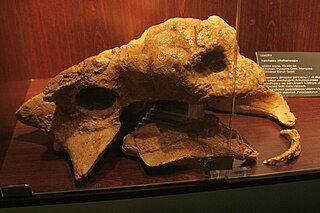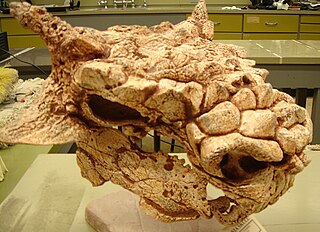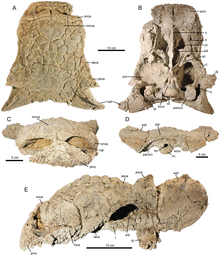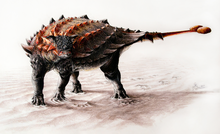
Ankylosaurus is a genus of armored dinosaur. Its fossils have been found in geological formations dating to the very end of the Cretaceous Period, about 68–66 million years ago, in western North America, making it among the last of the non-avian dinosaurs. It was named by Barnum Brown in 1908; it is monotypic, containing only A. magniventris. The generic name means "fused" or "bent lizard", and the specific name means "great belly". A handful of specimens have been excavated to date, but a complete skeleton has not been discovered. Though other members of Ankylosauria are represented by more extensive fossil material, Ankylosaurus is often considered the archetypal member of its group, despite having some unusual features.

Euoplocephalus is a genus of large herbivorous ankylosaurid dinosaurs, living during the Late Cretaceous of Canada. It has only one named species, Euoplocephalus tutus.

Zuul is a genus of herbivorous ankylosaurine dinosaur from the Campanian Judith River Formation of Montana. The type species is Zuul crurivastator. It is known from a complete skull and tail, which represents the first ankylosaurin known from a complete skull and tail club, as well as the most complete ankylosaurid specimen thus far recovered from North America. The specimen also preserved in situ osteoderms, keratin, and skin remains.

Edmontonia is a genus of panoplosaurin nodosaurid dinosaur from the Late Cretaceous Period. It is part of the Nodosauridae, a family within Ankylosauria. It is named after the Edmonton Formation, the unit of rock where it was found.

Pinacosaurus is a genus of ankylosaurid thyreophoran dinosaur that lived in Asia during the Late Cretaceous, mainly in Mongolia and China.

Saichania is a genus of herbivorous ankylosaurid dinosaur from the Late Cretaceous period of Mongolia and China.

Gastonia is a genus of herbivorous ankylosaurian dinosaur from the Early Cretaceous of North America, around 139 to 134.6 million years ago. It is often considered a nodosaurid closely related to Polacanthus. Gastonia has a sacral shield and large shoulder spikes.

Scolosaurus is an extinct genus of ankylosaurid dinosaurs within the subfamily Ankylosaurinae. It is known from the lower levels of the Dinosaur Park Formation and upper levels of the Oldman Formation in the Late Cretaceous of Alberta, Canada. It contains two species, S. cutleri and S. thronus. The type species, S. cutleri, measured up to 5.6 metres (18 ft) in length and 2.2 metric tons in body mass.
Shamosaurus is an extinct genus of herbivorous basal ankylosaurid ankylosaur from Early Cretaceous deposits of Höövör, Mongolia.

Gobisaurus is an extinct genus of herbivorous basal ankylosaurid ankylosaur from the Lower Cretaceous of China. The genus is monotypic, containing only the species Gobisaurus domoculus.

Talarurus is a genus of ankylosaurid dinosaur that lived in Asia during the Late Cretaceous period, about 96 million to 89 million years ago. The first remains of Talarurus were discovered in 1948 and later described by the Russian paleontologist Evgeny Maleev with the type species T. plicatospineus. It is known from multiple yet sparse specimens, making it one of the most well known ankylosaurines, along with Pinacosaurus. Elements from the specimens consists of various bones from the body; five skulls have been discovered and assigned to the genus, although the first two were very fragmented.

Nodocephalosaurus is a monospecific genus of ankylosaurid dinosaur from New Mexico that lived during the Late Cretaceous in what is now the De-na-zin member of the Kirtland Formation. The type and only species, Nodocephalosaurus kirtlandensis, is known only from a partial skull. It was named in 1999 by Robert M. Sullivan. Nodocephalosaurus has an estimated length of 4.5 metres and weight of 1.5 tonnes. It is closely related and shares similar cranial anatomy to Akainacephalus.
Shanxia is a monospecific genus of ankylosaurid dinosaur from the Shanxi Province that lived during the Late Cretaceous in what is now the Huiquanpu Formation. Shanxia may possibly represent a junior synonym of Tianzhenosaurus, an ankylosaurine also known from the Huiquanpu Formation of China.

The Kirtland Formation is a sedimentary geological formation.

Minotaurasaurus is a monospecific genus of ankylosaurid dinosaur that lived in Mongolia during the Late Cretaceous in what is now the Djadochta Formation. The type and only species, Minotaurasaurus ramachandrani, is known from two skulls, a cervical vertebra and a cervical half ring. It was named and described in 2009 by Clifford Miles and Clark Miles. The first fossils of Minotaurasaurus were illegally exported out of Mongolia.It has been suggested to be a synonym of Tarchia but more recent publications consider it as a distinct genus.

Ahshislepelta is a monospecific genus of ankylosaur dinosaur from New Mexico that lived during the Late Cretaceous in what is now the Hunter Wash Member of the Kirtland Formation. The type and only species, Ahshislepelta minor, is known only from an incomplete postcranial skeleton of a small subadult or adult individual. It was named in 2011 by Michael Burns and Robert M. Sullivan. Based on the size of the humerus, Ahshislepelta is larger than Pinacosaurus mephistocephalus but smaller than Talarurus and Pinacosaurus grangeri.

Oohkotokia is a genus of ankylosaurid dinosaur within the subfamily Ankylosaurinae. It is known from the upper levels of the Two Medicine Formation of Montana, United States. The discovery of Oohkotokia supports that Ankylosaurine dinosaurs existed and flourished continuously in Montana and/or Alberta throughout the late Campanian and early Maastrichtian stages in the Late Cretaceous period. It was a large, heavily built, quadrupedal, herbivore, that could grow up to 5 metres (16 ft) long and weigh up to 2 metric tons.
Zaraapelta is an extinct genus of herbivorous ankylosaurid thyreophoran dinosaur from the Late Cretaceous of Mongolia. The type species is Zaraapelta nomadis, named and described by Arbour et al in 2014. Zaraapelta is known from a single skull from the Barun Goyot Formation. It was found to be closest to Tarchia in the phylogenetic analysis within its description.

Platypelta is an extinct genus of herbivorous ankylosaurid dinosaurs within the subfamily Ankylosaurinae. It is known from the Late Cretaceous Dinosaur Park Formation of southern Alberta, Canada. The type species is Platypelta coombsi.

Akainacephalus is a monospecific genus of ankylosaurid dinosaur from southern Utah that lived during the Late Cretaceous in what is now the Horse Mountain Gryposaur Quarry of the Kaiparowits Formation. The type and only species, Akainacephalus johnsoni, is known from the most complete ankylosaur specimen ever discovered from southern Laramidia, including a complete skull, tail club, a number of osteoderms, limb elements and part of its pelvis, among other remains. It was described in 2018 by Jelle P. Wiersma and Randall B. Irmis. It is closely related and shares similar cranial anatomy to Nodocephalosaurus.























